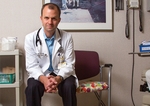profession
Work force issues to be examined in physician survey
■ Primary care doctors also are being asked how their practices have been impacted by the recession.
By Susan J. Landers — Posted Feb. 10, 2010
- WITH THIS STORY:
- » Related content
About 9,000 primary care physicians nationwide are being surveyed to examine work force matters, medical homes and other practice issues.
One goal is to help determine whether there are enough primary care physicians to tend to the nation's needs -- especially if insurance coverage is extended to more people in a reformed health system.
"There were discussions of shortages of primary care physicians, and we wanted to understand the nature of the shortage," said Edward Salsberg, director of the Assn. of American Medical Colleges' Center for Workforce Studies, which is reviewing the responses.
Reports of long waits to see primary care physicians in Massachusetts after the state extended health insurance coverage to nearly everyone also provided a push for the survey. Physicians in that state have been over-sampled to provide sufficient data to analyze, Salsberg said.
Questions on the four-page survey include asking whether physicians plan to work longer hours or hire more staff if they experience an influx of new patients. The survey also is assessing physicians' readiness to establish patient-centered medical homes, asking if electronic medical records or disease registries are part of their practice.
In addition, the survey is looking at the impact of the recession on doctors by inquiring about any decrease in patient visits or decline in charity care.
Primary care physicians and subspecialists in pediatrics and internal medicine received the surveys, Salsberg said. Collaborating on the effort with the AAMC are the American Medical Association, American College of Physicians, American Academy of Family Physicians, American Academy of Pediatrics, and American Assn. of Colleges of Osteopathic Medicine.
The AAMC will prepare reports based on the results, which are expected to be analyzed by March or April, Salsberg said.












